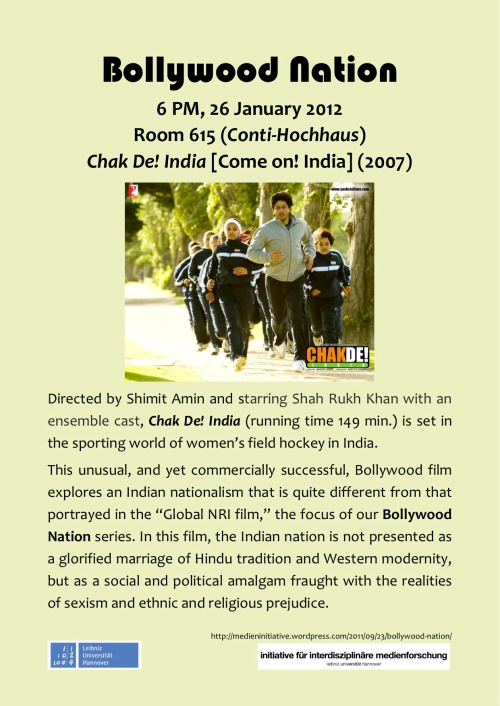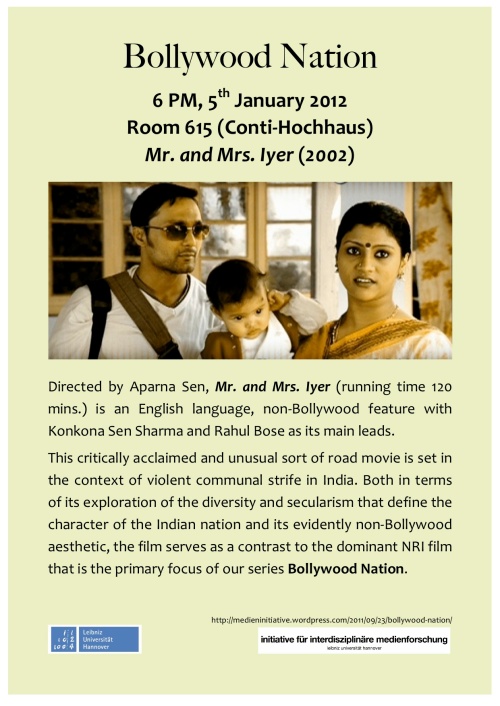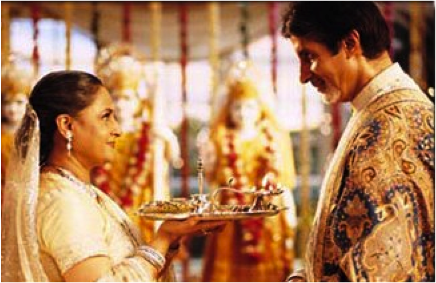On Thursday, January 26, 2012, we will be screening the fifth and final film in our Bollywood Nation series: Chak De! India [Come on! India] (and not, as previously announced, Kabhi Khushi Kabhie Gham…). As usual, the screening will begin at 6:00 PM (room 615 in the Conti-Hochhaus). More information about the film can be found on imdb.com.
Tag: Bollywood
Bollywood Nation: Mr. and Mrs. Iyer
On Thursday, January 5, 2012, we will be screening the fourth film in our Bollywood Nation series: Mr. and Mrs. Iyer. As usual, the screening will begin at 6:00 PM (room 615 in the Conti-Hochhaus). As indicated on our poster above, the 2002 film serves in several respects as a contrast to the other films in our series. More information about the film can be found on imdb.com.
Bollywood Gaga
[youtube http://www.youtube.com/watch?v=v8dJicEtrGs]
Apart from superheroes, politics, Photoshop, and video games (see yesterday’s post), two other obsessions interests of this blog over the past several months have been Bollywood and Lady Gaga. There are, of course, reasons for all of these things: my interest in superheroes is related to my work on comics, and they’ve been brought together with American politics (and especially #OWS) in ways that highlight the importance of visual and social media at the current moment, while, at the same time, I’ve been teaching a seminar on game studies this semester. Then there’s our still ongoing Bollywood Nation film series (in which three films have been screened so far, all starring Shah Rukh Khan), and I gave a presentation on Gaga last week at our conference on “Cultural Distinctions Remediated.” Strangely, all of these things are starting to come together: here, Shah Rukh Khan interviews Gaga on Indian television, going so far as to raise the prospect of Gaga acting in a Bollywood movie!
Bollywood Nation: Pardes
On Thursday, December 8, 2011, we will be screening the third film in our Bollywood Nation series: Pardes [Foreign Land]. The screening will begin at 6:00 PM (room 615 in the Conti-Hochhaus). The 1997 film, directed by Subhash Ghai, was a commercial success, both in India and abroad. More information about the film can be found on imdb.com.
Bollywood Nation: Dilwale Dulhania Le Jayenge
On Thursday, November 24, 2011, we will be screening the second film in our Bollywood Nation series: Dilwale Dulhania Le Jayenge [The Big Hearted Will Take the Bride]. Please note that this and subsequent screenings in the series are now scheduled to begin at 6:00 PM (room 615 in the Conti-Hochhaus).
The film, directed by Aditya Chopra and released in 1995, was the first successful new global NRI film, considered a classic of its kind. The short description at imdb.com indicates the global scope of the conflicts, concerns, and identities that inform the film:
“A young man and woman – both of Indian-descent, but born and raised in England – fall in love during a trip to Switzerland. However, the girl’s traditional father takes her back to India to fulfill a betrothal promise.”
Bollywood Nation: Background / Context
On the occasion of the first screening in our Bollywood Nation film series, which is set to begin in just under an hour from now (with Swades – more info below, and here), Jatin Wagle has put together the following very useful background information on Bollywood and tonight’s film.
Bollywood Nation
27.10.2011 – Swades: We, the People [Homeland] (Dir. Ashutosh Gowariker, 2004, 187 mins.)
Bollywood: A widely accepted but not unproblematic term for Hindi/Urdu/Hindustani language commercial cinema in India. The expression is problematic because it suggests a close relationship with or dependence on Hollywood. Even as American popular cinema remains an important frame of reference and influence for Hindi cinema, straightforward comparisons are not necessarily useful. Although the films are actually shot all over the world, the undisputed site of production of commercial Hindi cinema is the megacity of Mumbai (or Bombay as it was called before 1995). In this sense, Bollywood is both about India and Mumbai, or to be more precise, about the Indian nation as it is constantly imagined and staged in the crowded, multilingual diversity of the metropolis.
There are no clearly defined genres in Hindi commercial cinema. Instead, a typical Hindi film contains varying elements of romance, melodrama, action and comedy interspersed with song-and-dance sequences. The principal reason for this has been the complex mode of production – called “disaggregated” by M. Madhava Prasad – and the precarious mode of distribution of films in India. Although Hindi cinema has been perhaps the most significant site for the social/cultural negotiation of the Indian nation, until 2001 it was not accorded the status of an industry by the Indian Government. This has meant that over the years Hindi films have been financed through more-or- less informal networks, and this financial precariousness lies at the root of Hindi cinema’s reluctance to fragment its potential audiences. This used to be evident until a few years ago, i.e. before the advent of the multiplexes, in the typical experience of watching a Hindi film in an Indian city, when one invariably watched it with the family in a “cinema theatre” with a seating capacity of around a thousand. Thus, instead of genres, Hindi commercial cinema has historically developed a range of masala [Gewürzmischung] or formula films, i.e. mixes of or compromises between plot compositions, narrative structures and genre elements. For instance, the popular masala films of the 1970s were slight variations on either the lost-and-found/family reunion plot (e.g. Yaadon Ki Baaraat 1973) or the angry young man action hero format (e.g. Deewaar 1975, Amar Akbar Anthony 1977). From the mid-nineties, a new sort of masala film has become popular, with a diaspora setting (or at least a strong diaspora component) and an NRI (non-resident Indian) protagonist who portrays a guiltless blend of so-called Indian tradition with Western modernity.
Swades: We are beginning our film series titled, needless to say with obvious irony, “Bollywood Nation” with a film aptly called Homeland. Even with its NRI protagonist, played by Shahrukh Khan, and its partial diaspora setting, this film is untypical for a variety of reasons. Its expatriate protagonist is different from the typical hero of the recent NRI masala film. Although successful in the West, he is plagued by the guilt of having left behind the land of his past, a developing, third-world country with its complicated challenges, for a relatively uncomplicated life in the U.S. In terms of its aesthetic, the film is not obviously “camp” [filmy] and has been described as more “realistic” than a typical Bollywood film. Although it was not really a box office success within India, Swades sold well in what have been called the diaspora markets, and its music composed by A. R. Rahman became popular even within India. Ashutosh Gowariker, who wrote the script, and produced and directed the film, is known for at least one more film, Lagaan [Land Tax] (2001), which was nominated for the Academy Award for Best Foreign Language Film.
Bollywood Nation
The Initiative for Interdisciplinary Media Research and Jatin Wagle (in conjunction with his seminar “Long-Distance Hindu Nationalism and the Changing Figure of the Expatriate Indian in Contemporary Bollywood Cinema”) are proud to present a series of screenings this winter semester:
Bollywood Nation
From the first silent feature made in 1913, one of the many appeals of commercial Hindi cinema has been its persistent and multifarious staging of the Indian nationalism. It has been argued that the Bombay film constitutes a significant site for the popular negotiation of the Indian nation and that its history could even be told as an eccentric allegory of the checkered, postcolonial career of the Indian nation-state. In the 1960s and 1970s, for instance, when the “brain drain” paradigm ruled the official and dominant view of emigration in India, in the Hindi films the emigrant was portrayed as a sort of deficient Indian. His Indianness corrupted by Western decadence, he was someone who needed to be reformed, if not reviled. But, all this changed after the processes of economic liberalization were set in motion in 1991 and the Indian state started wooing the non-resident Indian (NRI). The new Bollywood NRI is not just an exemplary Indian, but even excessively so. In other words, he is more Indian than Indian, because he is both ultramodern and hypertraditional; he has a hugely successful career in the West, but his home is still an improbable oasis of Indian values and religiosity. Thus, the new Bollywood NRI embodies a deterritorialized cultural nationalism which utilizes the rhetoric of India’s alleged emergence as a global superpower. But, with the unprecedented global recognition and popularity of Bollywood, the rise of the new NRI has also been accompanied by an upsurge of Hindu nationalism within India and in the Indian diaspora. Does the changed socio-economic context and cinematic form account for Bollywood’s growing global appeal?
We plan to engage with these and other related issues in our series “Bollywood Nation” with five films to be screened between 27.10.2011 and 26.01.2012 at 18:00 in room no. 615.
27.10.2011 – Swades: We, the People [Homeland] (Dir. Ashutosh Gowariker, 2004, 187 mins.): A late renegotiation of the “brain drain” paradigm and could serve as a contrast to the new global NRI films. (more here)
24.11.2011 – Dilwale Dulhania Le Jayenge [The Big Hearted Will Take the Bride] (Dir. Aditya Chopra, 1995, 192 mins.): First successful new global NRI film, considered a classic of its kind. (more here)
08.12.2011 – Pardes [Foreign Land] (Dir. Subhash Ghai, 1997, 195 mins.): Another commercial success, both in India and abroad.
05.01.2012 – Mr. and Mrs. Iyer (Dir. Aparna Sen, 2002, 120 mins.): An English language, Indian film and not a Bollywood production; offers a contrasting aesthetic and another kind of negotiation with the composite idea of the Indian nation.
26.01.2012 – Kabhi Khushi Kabhie Gham… [Sometimes Happiness, Sometimes Sadness] (Dir. Karan Johar 2001, 210 mins.): One of the biggest commercial hits outside of India and the first Bollywood film to be released simultaneously in Germany, under the title In guten wie in schweren Tagen.





